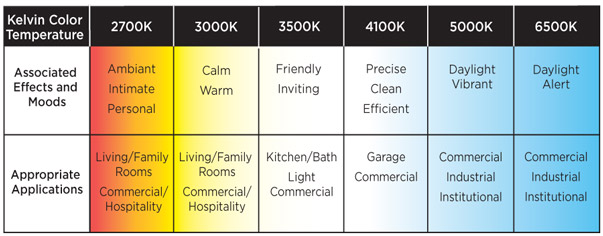Light Color: the Efficient and Happy Office Space
The lighting industry is of late highly focused on energy efficiency and cost of ownership. However, some long standing research, and some recent work point to a much greater savings in worker efficiency if the type of light and color of light are taken into account along with efficiency.
In the ’70s, fast food chains performed market research to investigate how customers responded to various colors in restaurant interiors and logo with interesting results. Some of there research found the following effects; in general, yellow, red, and orange are “exciting” and green, purple and blue are “calming” colors. Even the military got into the game with it’s own research, and soon after made paint color changes in ship common spaces, and light color most notably changing “Battle Lamps” from red to a shade of blue.
This chart shows Kelvin Color Temperatures and their effects in residential settings.
The Natick Soldier Research, Development and Engineering Center (NSRDEC) concluded in a recent study that LED lighting fostered a positive mood, increased alertness, and resulted in faster performance on visual perceptual and cognitive tasks. Soldiers working under fluorescent lights typically felt less alert, more fatigued and more depressed over time. They also demonstrated slower response times on cognitive tasks.
Researchers have studied the question of how lighting conditions affect mental stability for decades. In the 1940s, Luckiesh and Moss studied how fifth- and sixth-graders in well-lit and poorly lit classrooms performed on the New Stanford Achievement Test. Those in well-lit classrooms scored significantly higher than those in poorly lit classrooms. Since then, numerous researchers have studied the effects of fluorescent lighting. In a 2002 Guardian News article, Michaele Wynn-Jones investigated fluorescent lighting in prisons. Wynn-Jones concluded that fluorescent lighting is a likely cause of the headaches, depression and sleep disorders prisoners frequently experience.
According to researchers at the H.E.S.E project, the most common symptoms of having been exposed to too much fluorescent lighting and too little natural lighting are headaches, mood swings, irritability, insomnia and inappropriate behavior. John Ott further notes that continuous exposure to fluorescent lighting can lead to a depletion of the brain chemical serotonin. Known as a mood stabilizer, serotonin helps to keep mood disorders such as generalized anxiety disorder and depression at bay. Depleting the natural resources of serotonin in the brain can thus have serious and lasting consequences for emotional stability… more.
In conclusion light color makes a significant difference in the moods, behavior and work efficiency of all those present, so the next time you are looking at a simple lighting refresh or for easy methods of increasing office efficiency you should consider replacing fluorescent with white and color variable LED lighting your space.



